Cyberpunk 2077 Ray Tracing: Overdrive Mode - CD PROJEKT RED, RTX Inside The Game Interview
CD PROJEKT RED and NVIDIA are constantly pushing the boundaries of technology, and through our longstanding partnership, we’ve given PC gamers the definitive experience in Cyberpunk 2077 and The Witcher 3: Wild Hunt. In both, cutting-edge features have been employed to heighten immersion, increase image quality, reduce system latency, and accelerate performance.
We’re delighted to present a preview of next generation rendering with the release of the technology preview of Cyberpunk 2077’s Ray Tracing: Overdrive Mode, which upgrades the game with full ray tracing, otherwise known as path tracing.
The technology preview of Cyberpunk 2077’s Ray Tracing: Overdrive Mode launches today, taking lighting, shadowing and reflections to the next level. To learn more, we spoke to Jakub Knapik, Vice President and Global Art Director at CD PROJEKT RED.
Since release, Cyberpunk 2077 has included the most advanced technology and features around, including multiple ray tracing technologies, NVIDIA Reflex, and NVIDIA DLSS 2. On April 11th, you’re unveiling Full Ray Tracing with the technology preview of Ray Tracing: Overdrive Mode. What does this add for enthusiast gamers who play with graphics cranked up for the highest level of immersion and image quality?
A: With Cyberpunk 2077 and its Ray Tracing implementation, we always strived to create the most immersive and believable open-world experience. It was our goal from day one, and our cooperation with NVIDIA allowed us to push the boundaries of what was possible with the technology back then. But we didn’t just stop there.
After the game’s release, we started working on something that would push the experience to a new level. With Ray Tracing: Overdrive, aka Path Tracing, we fundamentally revamped the whole rendering and lighting pipeline with an approach that up until now was mainly known for its inclusion as part of visual effects in films and animations.
With Path Tracing, we allow all our lights in the game, sometimes hundreds or more sources of it, to provide pixel-perfect illumination and shadows across the whole visible world. We don’t reduce ourselves to a carefully selected group of lights that we can use, but we set ourselves totally wild and free.
Thanks to this approach, players get very organic looking and visually mesmerizing world representation with beautiful gradients and realism. I am aware that every few years someone goes and says that now lighting in games is more realistic, but I do feel that with Path Tracing we are really getting super close to giving players a totally cinematic experience, without having to hold back.
NVIDIA RTX Direct Illumination (RTXDI) is used to transform lighting, most noticeably in Night City. What has the freely-available SDK enabled you to achieve?
A: Night City is a super vibrant and complex cyberpunk megalopolis. It is full of light sources like lamps (both on the streets and above), spotlights, car lights, neons, screens, billboards, and more. There are moments in the game when the scene is full of light sources!
Traditionally, we had to carefully pick how many lights would cast shadows. It is a very well-known limitation of every real time rendering engine, and we were no different with our REDengine. So imagine that you see a busy street passage with plenty of merchant stalls, vending machines, lamps, and whatnot, but only a few of the lights on screen can cast shadows.
All other light sources just light through walls, objects, or characters, leading to potentially odd-looking and very disconnected lighting. RTXDI allows us to cast shadows from every possible light source on screen, be it a hundred or even more, with practically no limitations. It fundamentally changes the Direct Illumination realism and makes the whole world so much more grounded, deep, and dimensional.
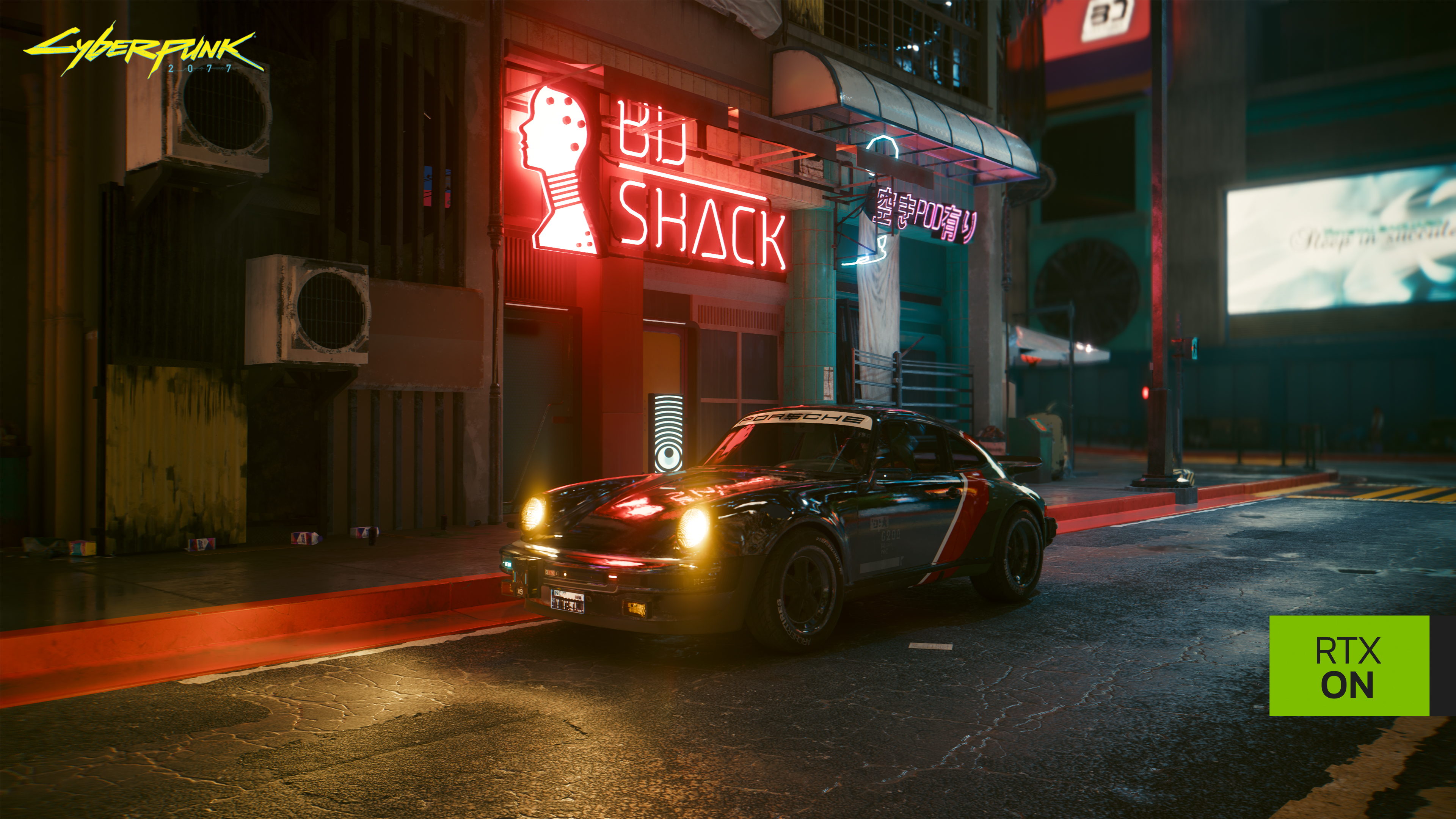
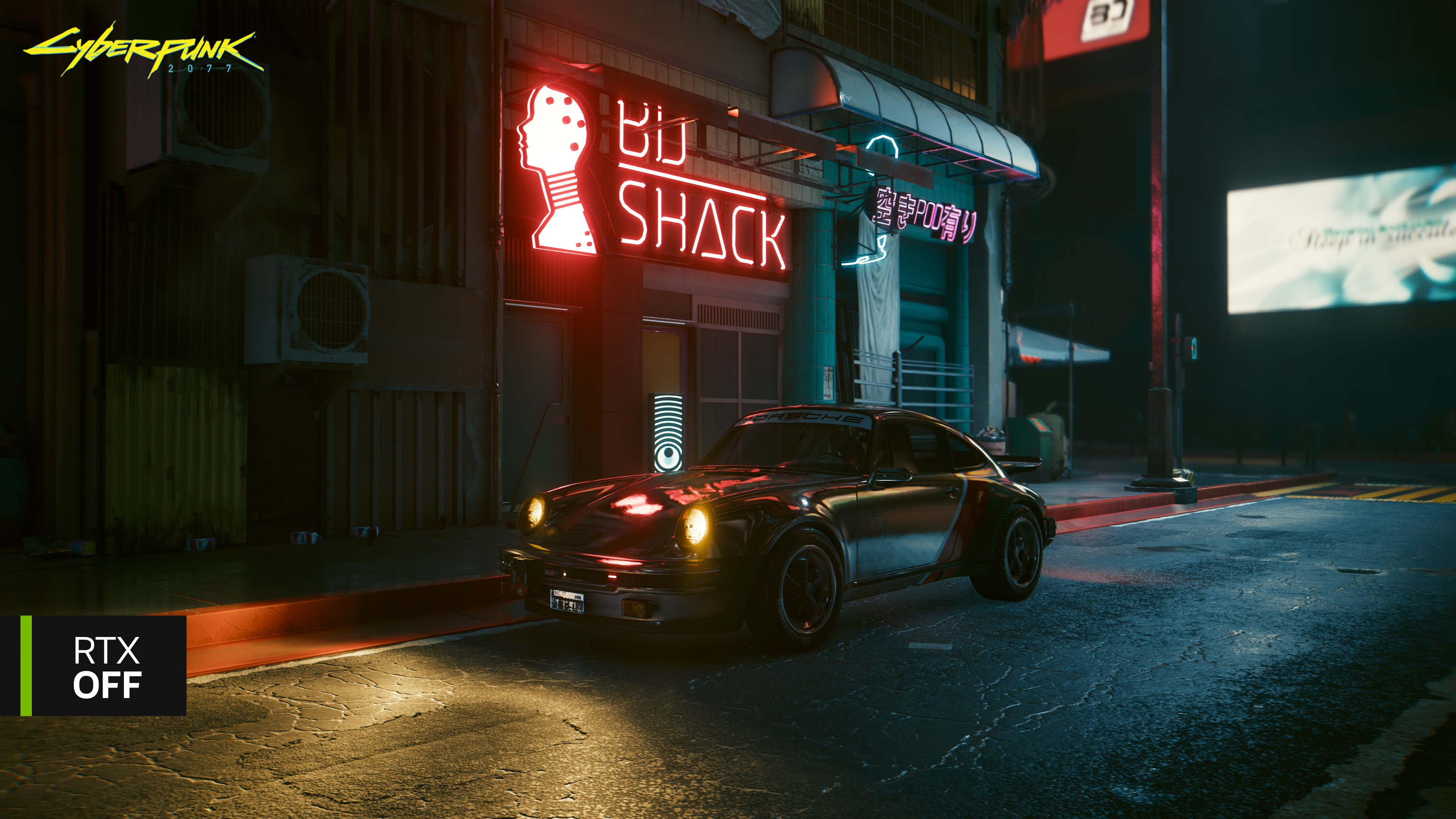
Full ray tracing helps with grounding objects within their surroundings, like the car above. Click here to view the comparison in 4K
Along with artificial lights, the technology preview of Ray Tracing: Overdrive Mode transforms natural lighting from the sun and moon. How does this differ from the existing ray-traced Global Illumination technology, and what software is used?
A: With the iteration of REDengine used for Cyberpunk 2077, we relied on a hybrid indirect illumination technique, one that would allow us to provide Global Illumination across all target platforms. To do that, we used a GI Probes-based system that provided a dynamic solution for all the lights in the game within a certain distance from the camera and within a fixed world space resolution that was manually set per location depending on the needs, in most cases between 1.5m to 4m.
This solution provides indirect diffuse to the geometry in the game. With Ray Tracing: Ultra and Ray Tracing: Psycho settings we also provide a significantly more precise, but somewhat delicate indirect diffuse response for sunlight. With the new Ray Tracing: Overdrive, we decided to go all the way, as Path Tracing provides us with the most accurate solution we could wish for.
Thanks to this we are totally free, no longer constrained by a fixed world space grid of probes and a rather small resolution of the system, and can provide a super detailed, pixel perfect, incredibly realistic indirect illumination. What’s more, we no longer provide just indirect diffuse, but also indirect specular response. As a result, light has so much more directionality and makes the visible world deeper and simply more beautiful.
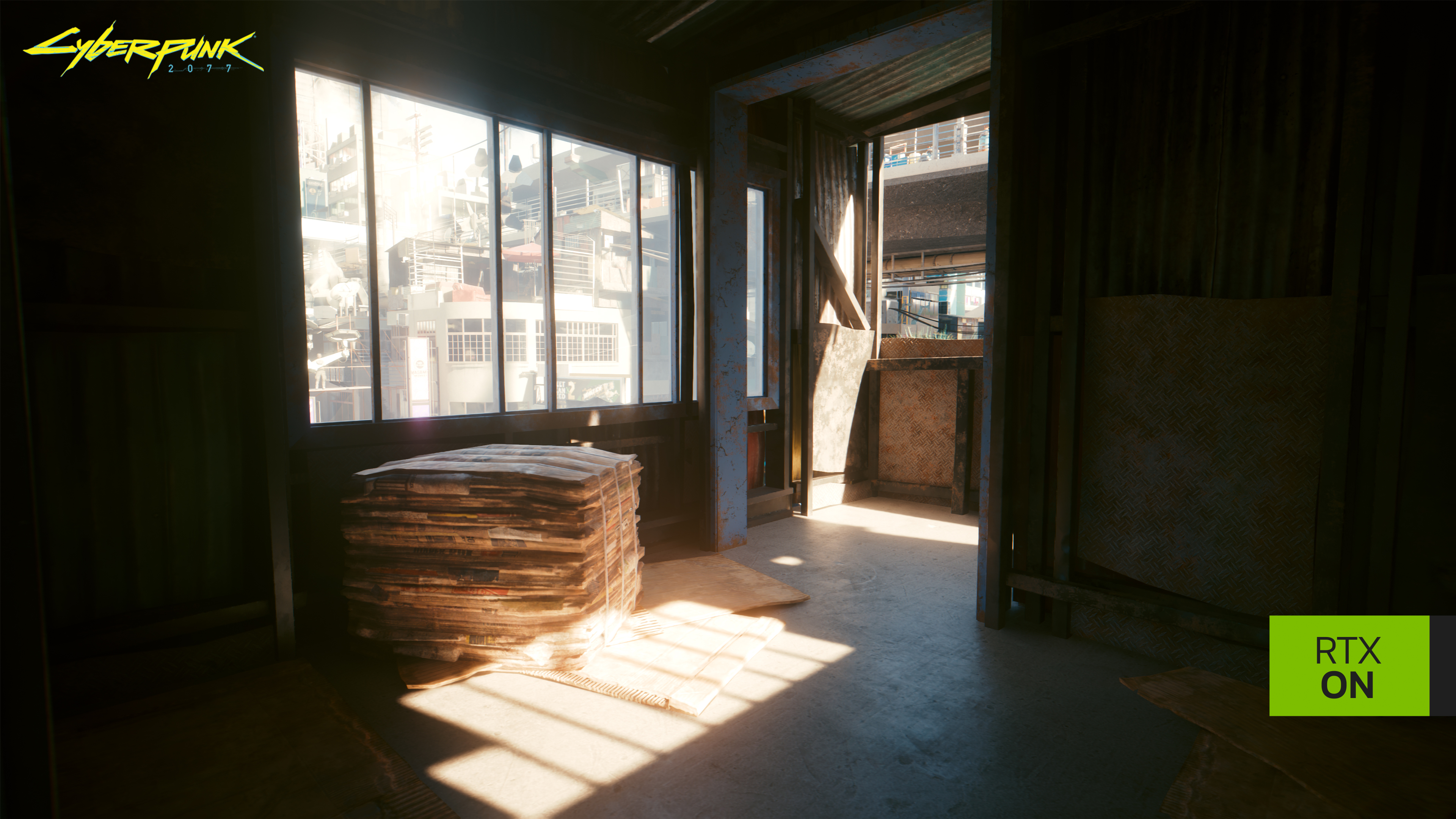
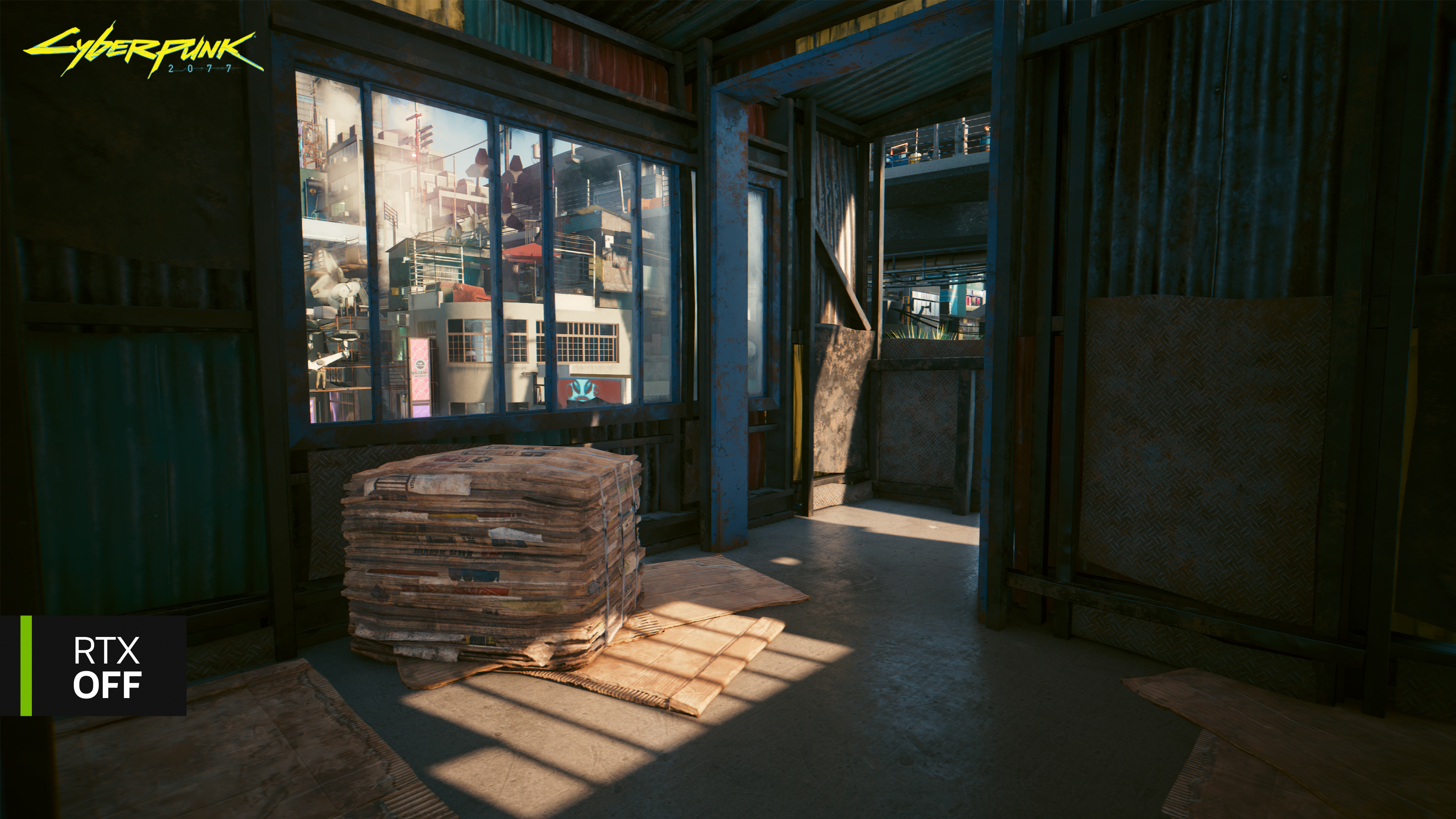
The sunlight bounces off the floor to indirectly light a cardboard stack for more realistic lighting and occlusion. Click here to view the comparison in 4K
Along with Global Illumination, the unified full ray tracing of the update also improves your class-leading ray-traced reflections. What improvements will gamers experience?
A: With Ray Tracing: Overdrive, we can finally experience fully balanced light transition through the game. Light rays bounce through the world, providing both illumination and reflections. To strike a balance between performance and quality, we decided that two ray bounces will provide a sweet spot in that regard. This means that when we look in a mirror, we see a reflective surface that still reflects the world properly.
Previously we could only hope for one bounce. As a result, some rooms or surfaces looked somewhat darker, as a single light ray was not enough to provide proper information about the world, thus missing that one part of the puzzle. For players, Ray Tracing: Overdrive means that even very glossy interiors or super complex rooms will look very natural and sophisticated, providing a very immersive experience.
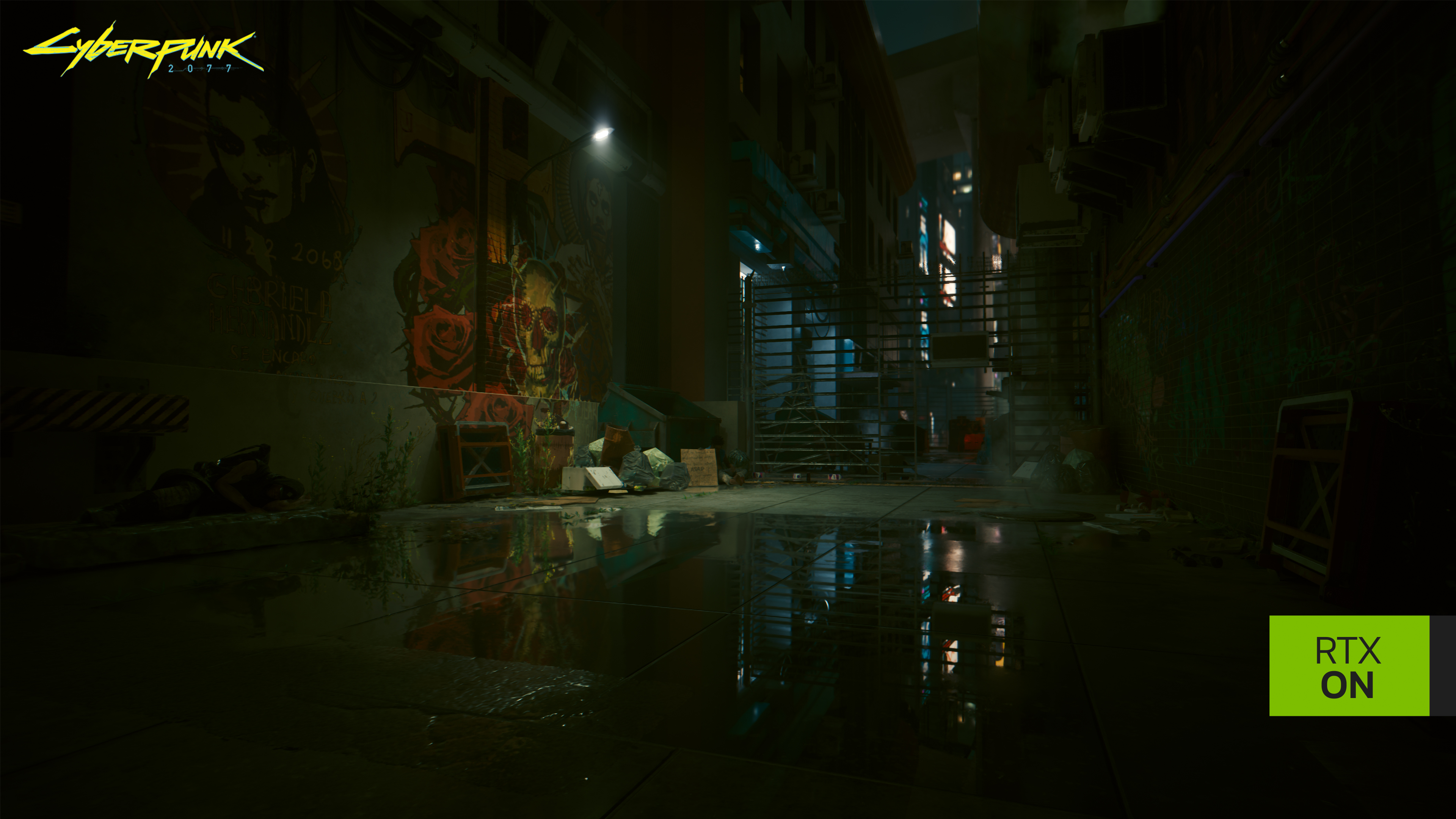

Full ray tracing helps to balance the diffuse and specular response of materials to the light, resulting in even more realistic reflections. Click here to view the comparison in 4K
What was your first thought when you turned DLSS 3 on in Cyberpunk 2077?
A: I remember when we were introduced to the idea behind DLSS 3 months before we could actually test it, and it already sounded quite amazing, actually. When you run it, it does feel quite surreal to be able to make a game run almost twice as fast with the flip of a switch. In all honesty, it does at times feel like real-life magic. It does look like a super smart solution to a problem that the industry was looking to solve for years.
Did the existence of DLSS 3 make the Ray Tracing: Overdrive Mode a reality?
A: When working on Ray Tracing: Overdrive, I did often see changes in the performance based on the state of development we were currently in, but it was always rather certain that this is the technology of the future and will require super powerful hardware for the best performance.
Ray Tracing: Overdrive actually started as a solution for Cyberpunk 2077’s Photo Mode; that was the initial idea I had. This changed when NVIDIA’s team shared plans for their future technology, which looked like it could really make it possible to play at that quality in real time. I was blown away by the possibility and we instantly moved our efforts towards that direction. DLSS 3 was a key element in making it possible.
Concurrently with the integration of DLSS 3, you also brought NVIDIA Reflex to Cyberpunk 2077, for all gamers dating back to those using GeForce GTX 900 Series GPUs. What did the integration process entail, and what quantifiable benefits does Reflex deliver for Cyberpunk 2077 players?
A: Reflex is a solution that plays really well with DLSS 3, because it focuses on minimizing the input lag in the game. In action-heavy moments, you need the game to respond as swiftly as possible, especially with the high frame rates provided by DLSS 3.
The integration process went smoothly. Through our close collaboration with NVIDIA engineers, we were able to quickly identify the places to integrate parts of Reflex that measure particular frame parts and optimize those in terms of capturing input.
As a player, you will mostly see the benefits in places where accuracy and responsiveness are crucial, so situations like driving through dense parts of Night City at high speeds or taking part in challenging shootouts as you are progressing through the story.
Does DLSS 3’s proven Frame Generation technology influence your plans for future games, making you more ambitious, increasing detail and immersion because you know a large number of gamers will be able to view and appreciate your worlds at launch? Is Frame Generation the future?
A: Absolutely, this technology allows us to target a quality level that is higher than ever before. It adds that extra level of headroom for us when thinking of the game’s graphical settings, but also some creative decisions in the future.
With fully ray traced game graphics now approaching and sometimes surpassing the quality of CG in some television shows, what in your opinion is the next development challenge to surmont?
A: I do feel the next step lies in AI integration that goes beyond the development phase of projects. It is a new and very much uncharted world that we’re getting to and it is up to us to find a way to marry the heart and soul of developers and the near limitless muscle power that this new technology provides. But AI can also dramatically change the way the game world interacts with the player, and it’ll be extremely interesting to see that area grow and evolve in the future.
Thanks so much for your time. Before we sign off, is there anything else you would like to add about Cyberpunk 2077 or its technology?
A: I would like to share that I am super excited about Cyberpunk 2077’s Ray Tracing: Overdrive mode that we’re releasing to players very soon now. I really do hope they will share our passion for this technology, even if it is just a glimpse into the future. There always needs to be that first step that many will question, but one that needs to happen before change arrives. We worked super hard, both CD PROJEKT RED and NVIDIA, to make this new graphical mode a reality, and give players something very special — like we always aim to do with our games.
---------------
The technology preview of Cyberpunk 2077’s Ray Tracing: Overdrive Mode is out today on all PC store fronts where Cyberpunk 2077 is sold. For further details, check out our Cyberpunk 2077 Ray Tracing: Overdrive Mode Technology Preview announcement article, and be sure to download our latest Game Ready Driver to ensure the best experience from the second you start playing with full ray tracing and DLSS 3 enabled.